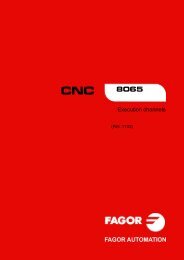4 - Fagor Automation
4 - Fagor Automation
4 - Fagor Automation
You also want an ePaper? Increase the reach of your titles
YUMPU automatically turns print PDFs into web optimized ePapers that Google loves.
Canned cycles (·M· model)<br />
3 Rapid movement (G0) of the longitudinal axis up to 1 mm off the part surface.<br />
The movement permits, as in the case of the figure, a fast approach to the machining<br />
surface when the safety coordinate (Z) is far away from the surface.<br />
4 Penetration. The longitudinal axis penetrates into the part the distance indicated by "B"<br />
and at the feedrate indicated by "V".<br />
5 Milling of the pocket surface at work feedrate in the passes defined by "C" up to a distance<br />
"L" (finishing pass) from the pocket wall. It is carried out in the direction indicated by<br />
parameter "J".<br />
6 Finishing milling, "L" amount, at the work feedrate defined by "H".<br />
In order to obtain good part finish when machining the pocket walls, the finishing passes<br />
are carried out with tangential entry and exit.<br />
7 Rapid withdrawal (G0) to the center of the pocket, 1 mm off the machined surface.<br />
8 New milling surfaces until reaching the total depth of the pocket.<br />
Penetration, at the feedrate indicated in "F" up to a distance "B" from the previous<br />
surface.<br />
Milling of the new surface following the steps indicated in points 5, 6 and 7.<br />
9 Withdrawal to the starting plane (Zi) if function G98 is active or to the reference plane<br />
(Z) if function G99 is active.<br />
1.<br />
MILLING CANNED CYCLES.<br />
G87. Rectangular pocket canned cycle.<br />
CNC 8065<br />
(REF: 1209)<br />
·51·

















